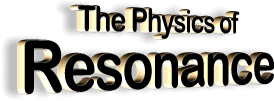|

from
Intuitor Website
Introduction
Resonance is a common thread which runs through almost every branch
of physics, and yet a lot of people have never studied it. Without
resonance we wouldn't have radio, television, music, or swings on
playgrounds, not to mention cool gismos like Tesla coils. Of course,
resonance also has its dark side. It occasionally causes a bridge to
collapse, a helicopter to fly apart, or other inconveniences.
Unlike
black holes,
time travel, and
quantum mechanics, resonance is common place and easy to observe.
Yet, it is one of the most striking and unexpected phenomenon in all
of physics.
The following report is the most comprehensive on resonance
available on the web. Its information is intended especially for use
by high school students, teachers, home schools, and anyone
interested in the subject. Suggestions for quick demos are included
in many of the sections and are noted on the contents page. More
elaborate demos and lab experiments are described in separate
sections which contain the word demonstration in the title.
The materials and parts specified in the demonstrations are based on
items commonly found in the United States since that is where the
demonstrations were built and tested.
However, we sincerely hope our
international readers will be able to gain some useful ideas.
Contents
-
Resonance Basics
-
Nikola Tesla - Master of
Resonance: Tesla was a genius who was
obsessed with resonance. No discussion of resonance
could be complete with out talking about Tesla.
-
The ABC's of Resonance:
Find out what resonance is and why it happens.
-
Vibrations/Oscillations
-
Playground Swings:
This is the example Tesla used when he gave
explanations of resonance. (Demo)
-
Sound
-
An Incredibly Irritating
Resonance Demonstration: This easy-to-do
demo creates an unexpected, incredibly ear
splitting, and annoying sound. It's one of the most
dramatic high school physics demos available.
-
Electrical/Magnetic
Resonance
-
Electrical Circuits
Anything which moves can potentially resonate, even
the electrons in a circuit.
-
Crystal Radio Demonstrations
Crystal radios are simple circuits designed to
resonate at the same frequency as the radio station
they're tuned to receive.
-
How Antennas Work
You guessed it. They resonate (at least the most
efficient ones do).
-
Standing Electrical Waves
Demonstration Actually see standing
electrical waves using an ordinary florescent tube.
-
Antenna Demonstrations
Shows that simple antenna's work best when their
length is adjusted so that they resonate. Also shows
that simple antennas emit polarized waves.
|
